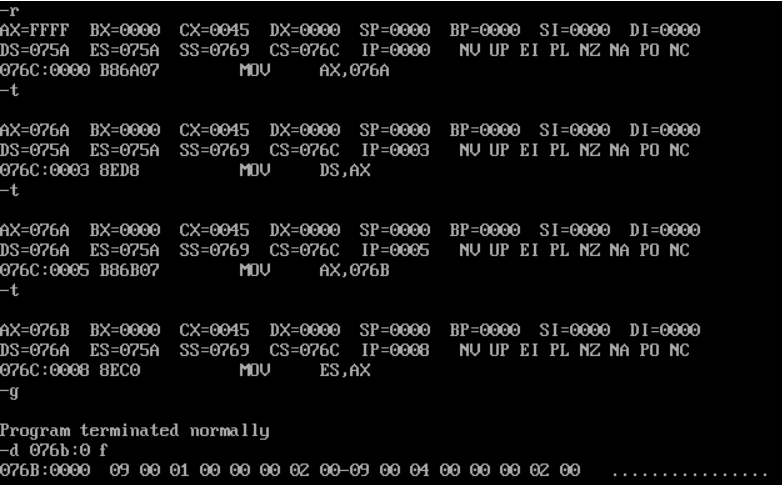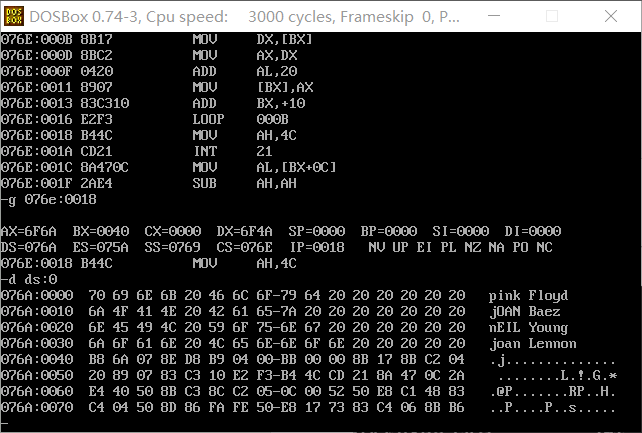1. Experimental Task 1
Tasks 1-1
task1_1.asm
assume ds:data, cs:code, ss:stack
data segment db 16 dup(0) ; Reserve 16 byte cells with initial values of 0 data ends
stack segment db 16 dup(0) ;Reserve 16 byte cells with initial values of 0 stack ends code segment start: mov ax, data mov ds, ax
mov ax, stack mov ss, ax mov sp, 16 ; Set top of stack
mov ah, 4ch int 21h code ends end start

(1) In debug, before the end of line17 and line19, record this time: Register (DS) = _076A_u, Register (SS) = u 076B_u, Register (CS) = _076C_u_
(2) Assuming that the segment address of the code segment is X after loading the program, the segment address of the data segment is u X-0002H_u, The segment address of the stack is u X-0001H_u.
Tasks 1-2
task1_2.asm
assume ds:data, cs:code, ss:stack
data segment db 4 dup(0) ; Reserve 4 byte cells with initial values of 0 data ends
stack segment db 8 dup(0) ; Reserve 8 byte units with initial values of 0 stack ends code segment start: mov ax, data mov ds, ax
mov ax, stack mov ss, ax mov sp, 8 ; Set top of stack
mov ah, 4ch int 21h code ends end start

(1) In debug, before the end of line17 and line19, record this time: Register (DS) = _076A_u, Register (SS) = u 076B_u, Register (CS) = _076C_u_
(2) Assuming that the segment address of the code segment is X after loading the program, the segment address of the data segment is u X-0002H_u, The segment address of the stack is u X-0001H_u.
Tasks 1-3
task1_3.asm
assume ds:data, cs:code, ss:stack data segment db 20 dup(0) ; Reserve 20 byte units with initial values of 0 data ends stack segment db 20 dup(0) ; Reserve 20 byte units with initial values of 0 stack ends code segment start: mov ax, data mov ds, ax mov ax, stack mov ss, ax mov sp, 20 ; Set Initial Stack Top mov ah, 4ch int 21h code ends end start

(1) In debug, before the end of line17 and line19, record this time: Register (DS) = _076A_u, Register (SS) = u 076C_u, Register (CS) = _076E_u_
(2) Assuming that the segment address of the code segment is X after loading the program, the segment address of the data segment is u X-0004H_u, The segment address of the stack is u X-0002H_u.
Tasks 1-4
task1_4.asm
assume ds:data, cs:code, ss:stack code segment start: mov ax, data mov ds, ax
mov ax, stack mov ss, ax mov sp, 20
mov ah, 4ch int 21h code ends
data segment db 20 dup(0) data ends
stack segment db 20 dup(0) stack ends
end start

(1) In debug, before the end of line17 and line19, record this time: Register (DS) = _076C_u, Register (SS) = u 076E_u, Register (CS) = _076A_u_
(2) Assuming that the segment address of the code segment is X after loading the program, the segment address of the data segment is u X+0002H_u, The segment address of the stack is u X+0004H_u.
Tasks 1-5 summarize and answer based on the practice and observation of the four experimental tasks mentioned above:
(1) For a segment defined below, the amount of memory space actually allocated to that segment after loading is u N bytes u.
xxx segment db N dup(0) xxx ends
(2) If the program task1_ 1.asm, task1_ 2.asm, task1_ 3.asm, task1_ 4. In asm, the pseudo-directive end start is changed to end, which program can still execute correctly? Combined with the conclusions obtained from practical observation, the reasons are analyzed and explained.
A: task1_4.asm, after the pseudo instruction end start is changed to end, the program executes from the beginning, only task1_4.asm satisfaction
2. Experimentation Task 2 writes an assembly source program to fill successively 160 bytes of hexadecimal data 03 04 into memory unit b800:0f00 ~ b800:0f9f.
assume cs:code code segment mov ax, 0b800h mov ds, ax mov bx, 0f00h mov ax, 0403h mov cx, 160 s: mov [bx], ax add bx, 2 loop s mov ah, 4ch int 21h code ends end

3. Experimental Task 3
The code snippet for the 8086 assembly source program task3.asm is known below.
task3.asm
assume cs:code data1 segment db 50, 48, 50, 50, 0, 48, 49, 0, 48, 49 ; ten numbers data1 ends data2 segment db 0, 0, 0, 0, 47, 0, 0, 47, 0, 0 ; ten numbers data2 ends data3 segment db 16 dup(0) data3 ends code segment start: mov ax,data3 mov ds,ax mov ax,data1 mov es,ax mov cx,10 mov bx,0 s1: mov al,es:[bx] add [bx],al inc bx loop s1 mov ax,data2 mov es,ax mov cx,10 mov bx,0 s2: mov al,es:[bx] add [bx],al inc bx loop s2 mov ah,41h int 21h code ends end start
date1

date2

date3

When added:

4. Experimental Task 4
The code snippet for the 8086 assembly source program task4.asm is known below.
task4.asm
assume cs:code data1 segment dw 2, 0, 4, 9, 2, 0, 1, 9 data1 ends data2 segment dw 8 dup(?) data2 ends code segment start: mov ax,data1 mov ds,ax mov ax,data2 mov es,ax mov sp,16 mov bx,0 mov cx,8 s1: push [bx] add bx,2 loop s1 mov bx,0 mov cx,8 s2: pop [bx] add bx,2 loop s2 mov bx,0 mov cx,8 s3: mov ax,[bx] mov es:[bx],ax add bx,2 loop s3 mov ah, 4ch int 21h code ends end start

5. Experimental Task 5
Use any text editor to enter the assembly source program task5.asm.
task5.asm
assume cs:code, ds:data data segment db 'Nuist' db 2, 3, 4, 5, 6 data ends code segment start: mov ax, data mov ds, ax mov ax, 0b800H mov es, ax mov cx, 5 mov si, 0 mov di, 0f00h s: mov al, [si] and al, 0dfh mov es:[di], al mov al, [5+si] mov es:[di+1], al inc si add di, 2 loop s mov ah, 4ch int 21h code ends end start

The function of line19 is to convert letters to uppercase and lowercase
The effect of line4 is to change the color of the display
6. Experimental Task 6
The code snippet for the 8086 assembly source program task6.asm is known below.
task6.asm
assume cs:code, ds:data data segment db 'Pink Floyd ' db 'JOAN Baez ' db 'NEIL Young ' db 'Joan Lennon ' data ends code segment start: mov ax,data mov ds,ax mov cx,4 mov bx,0 s: mov dx,[bx] mov ax,dx add al,32 mov [bx],ax add bx,16 loop s mov ah, 4ch int 21h code ends end start

assume cs:code, ds:data, es:table data segment db '1975', '1976', '1977', '1978', '1979' dw 16, 22, 382, 1356, 2390 dw 3, 7, 9, 13, 28 data ends table segment db 5 dup( 16 dup(' ') ) ; table ends code segment start: mov ax,data mov ds, ax mov ax,table mov es, ax mov si,0 mov di,0 mov cx,5 s: mov ax,ds:[si] mov es:[di], ax mov ax,ds:[si+2] mov es:[di+2], ax mov ax,ds:[si+84] mov es:[di+5],ax mov dx,ds:[si+84+2] mov es:[di+7],dx push cx mov cx,ds:[84+84+bx] mov es:[di+0ah],cx div cx pop cx mov es:[di+0dh],ax add si,4 add bx,2 add di,16 loop s mov ah, 4ch int 21h code ends end start
table raw data:

After running:
